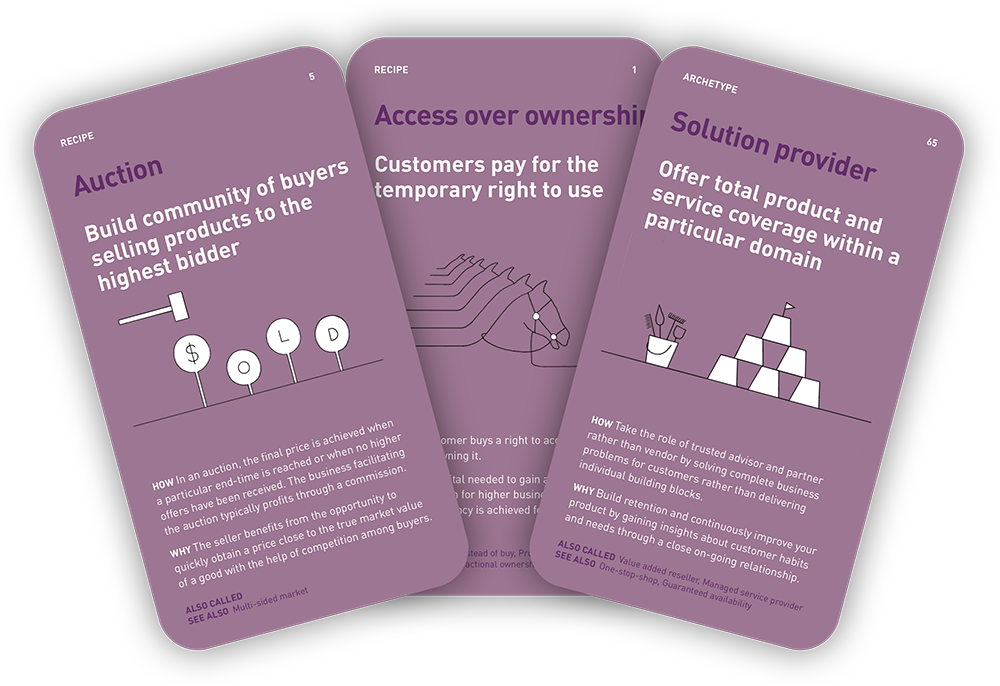Element
Also called: Performance-based pricing, Outcome-based contracting
See also: Access over Ownership, Guaranteed Availability, Pay Per Use
| Key Partners | Key Activities | Value Propositions | Customer Relationships | Customer Segments | |||||
| Key Resources | Channels | ||||||||
| Cost Structures | Revenue Streams | ||||||||
How: Develop performance metrics and relate contracting payment to performance against these metrics. Metrics aim to motivate the supplier to continuously enhance practices and could be availability, reliability, supportability, or total cost of ownership.
Why: The strong optimization focus on outputs, quality, and outcomes translates well into a focus on meeting the needs of the user.
This business model is part of the Business Model Patterns printed card deck.
A collection of business models that will help you understand the key drivers of business model success. The card deck will be ready for purchase in the end of 2023 and is now undergoing rigorous testing.
Reserve your deck!Performance-Based Contracting is a pricing strategy that calculates the value of a product based on the services it renders, rather than its face value. This method allows customers to better control their costs by paying a specified amount that includes all pertinent expenses such as operation, maintenance, and repair.
There are a number of recurring characteristics of business models implementing the Performance-Based Contracting pricing strategy:
- Measurement of Services. The services rendered by the product are measured as a precise output quantity, and the use-intensity of the product is irrelevant to pricing. This approach is fundamentally different from Pay Per Use, as it focuses on the value provided by the product rather than its usage.
- Manufacturer Integration. Manufacturers who distribute products under this pricing strategy are often deeply integrated into customers’ value creation processes. This allows them to pass on past experience with the product and build new expertise in its use, creating long-term and cooperative relationships with customers.
- Integrated Own-and-Operate Systems. An extreme variant of Performance-Based Contracting is the use of Integrated Own-and-Operate systems, where a company retains ownership of and operates the product that another company has bought. Despite the increased financial and operational risk, this approach can lead to even more mutually beneficial partnerships with customers.
Where did the Performance-Based Contracting business model pattern originate from?
Performance-Based Contracting has its roots in public sector infrastructure policies, which have been applied in public-private partnerships (PPPs) since the mid-twentieth century. These cooperative agreements between public authorities and private enterprises involve the grant of concessions to companies, legally authorizing them to perform public functions. Under this system, companies are remunerated based on the fulfillment of demand, for example, the number of available kindergarten places they have created. In other words, payment is contingent on achieving results.
Over time, results-based compensation found its way into the private sector. One notable pioneer in this regard was the British aircraft engine manufacturer, Rolls-Royce. In the early 1980s, the company achieved large-scale success with its power-by-the-hour scheme. Rather than selling engines outright, Rolls-Royce offers its customers performance per flying hour. The engines are owned, maintained, and repaired by Rolls-Royce, and the power-by-the-hour program is highly popular with customers. Today, the company generates over 70% of its revenues through this approach.
Applying the Performance-Based Contractingising business model
Performance-Based Contracting allows businesses to monetize existing knowledge and services, including process knowledge, maintenance know-how, and related services. This approach is particularly effective when dealing with complex products that have a challenging application.
Customers who wish to avoid upfront costs will likely prefer Performance-Based Contracting, as it allows them to have increased transparency and stability in the costs of final products and services. Additionally, this pattern works well for customers who desire to have a long-term and cooperative relationship with the supplier.
Advantages of Performance-Based Contracting & Pricing
Performance-based pricing offers several advantages, including alignment between the buyer’s goals and the seller’s goals, insurance for both parties, and improved communication and cooperation.
- Insurance for Both Parties. Performance-based pricing acts as insurance for both parties by ensuring that the seller does not undercharge the buyer and that the buyer does not overpay. This creates a greater sense of fairness for both parties and reduces the risk for individuals involved in the purchase decision.
- Improved Communication and Cooperation. Performance-based pricing arrangements are generally intricate and require open communication between the buyer and seller. This detailed discussion of conflicting objectives and trade-offs leads to better agreements that provide more value to the buyer and lower costs to the seller. The process also helps to improve communication and coordination within buyer and seller groups and promotes a win-win relationship.
- Proven in Practice. Performance-based pricing has been successfully deployed by several credible players, such as EDS in systems integration and outsourcing, and has been proven to be implementable. The advertising industry has been a fertile field for performance-based pricing, with many advertisers and advertising agencies moving in this direction.
When to apply Performance-Based Contracting & alternatives
Performance-based pricing is not always the best solution, and is only appropriate in a limited number of situations. It is complicated and requires careful implementation, and is not a halfway solution. Other pricing strategies such as usage-based pricing or point guarantees may be more suitable in certain circumstances.
Performance-Based Contracting is a powerful model to align both buyer and seller goals, managing risk, and fostering cooperation. It is not appropriate for all situations and its complexity requires careful planning and execution.
Guidelines for Implementing Performance-Based Pricing
The following are guidelines for successfully implementing performance-based pricing and evaluating whether it is a fit for you.
Carefully plan
- Invest the time up-front to carefully and fully define the objectives of the project and exchange all the relevant information.
- Broaden the negotiation perspective to encompass all elements of the situation.
- Explore a wide range of outcomes and consider what is controllable by the seller, the buyer, and neither.
- Take the time to negotiate completely. Do not rush because important details can and will be lost in haste.
Define “Good Performance”
- Develop clear measures of achievement for each objective.
- Specify precisely what “performance” means.
- Enumerate an explicit formula to relate payment price to performance outcomes.
- Specify a mechanism to adjudicate disagreements over outcome measurement.
Performance-Based Contracting is most beneficial in situations where the outcomes are uncertain, but the process of careful negotiation and planning can illuminate new ways of cooperation between the buyer and seller.
Trigger Questions
- Is it an issue for customers today that they cannot manage their costs by actual usage?
- How can you deliver knowledge and services that will allow for additional value creation and for customers to manage their costs and performance even better?
- What are the true needs of our clients?
- Would our clients prefer a cost structure that offers them transparency, enabling them to regulate their expenses through actual usage?
- How can we architect our value chain to enhance performance and dependability?
Examples
Rolls-Royce
By retaining ownership and maintenance obligations, its aircraft engines are billed for every hour of performance of the engine.
Xerox
Beat the printing industry by pioneering its pricing model to charge per page printed rather than for the equipment.
BASF Coatings
The chemical industry company, has been using Performance-Based Contracting in their “cost per unit” models since the late 1990s. In this model, the cost of vehicle coatings is calculated per item or module coated, rather than by the amount of paint used. This approach allows customers to improve their efficiency and any savings achieved are split between customers and the company, creating a mutually beneficial situation.
Smartville
At the manufacturing plant based in France for the motor car brand Smart, vehicles are manufactured to order with a modular delivery of systems from suppliers, whose close proximity allows for greater communication, rapid testing, and delivery without the need for long-term storage on site. This approach results in shorter production time, lower costs, more efficient collaboration between the suppliers, and ultimately leads to higher revenue.
ABB and Ford
Ford needed a world-class supplier to design and build a turnkey automotive painting facility in Oakville, Canada. The initial preparatory phase involved a significant exchange of information and perspectives between the two firms, leading to a novel type of agreement. ABB would design and build the plant at a far lower cost than standard. If ABB could reduce the cost even further, it would receive a pre-agreed percentage of the savings. This innovative, performance-based approach left both parties significantly better off than under conventional bidding or a negotiated price arrangement. Ford received a significantly lower cost at a lower level of risk, while ABB received a share in the cost and design improvements it was able to create.
Source: Is Performance-Based Pricing the Right Price for You?
Related plays
- Business Model Navigator by Karolin Frankenberger and Oliver Gassmann
- Performance-Based Contracting by Wikipedia
- Is Performance-Based Pricing the Right Price for You? by Benson Shapiro
- Contracting for performance: Unlocking additional value by Roman Belotserkovskiy

